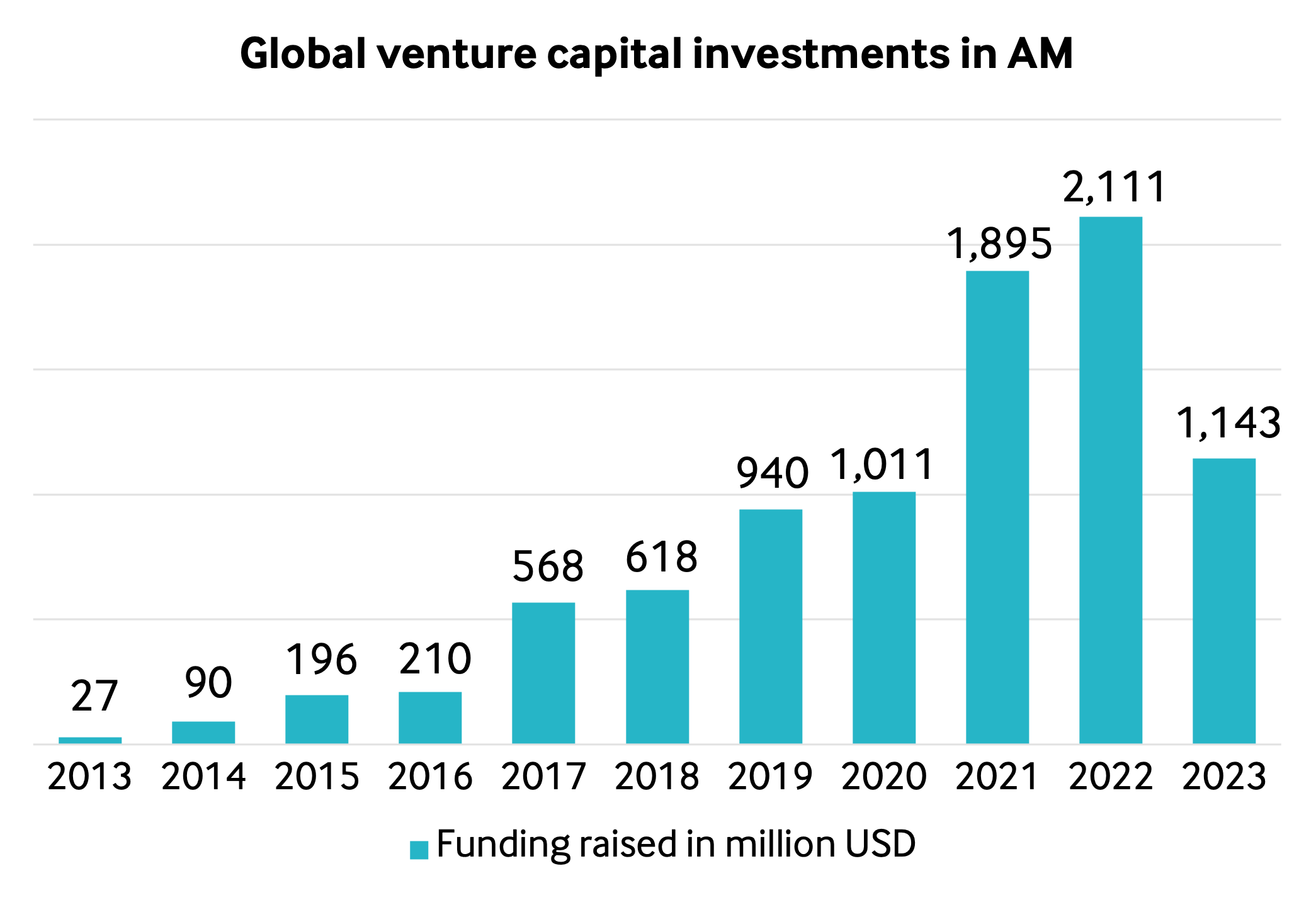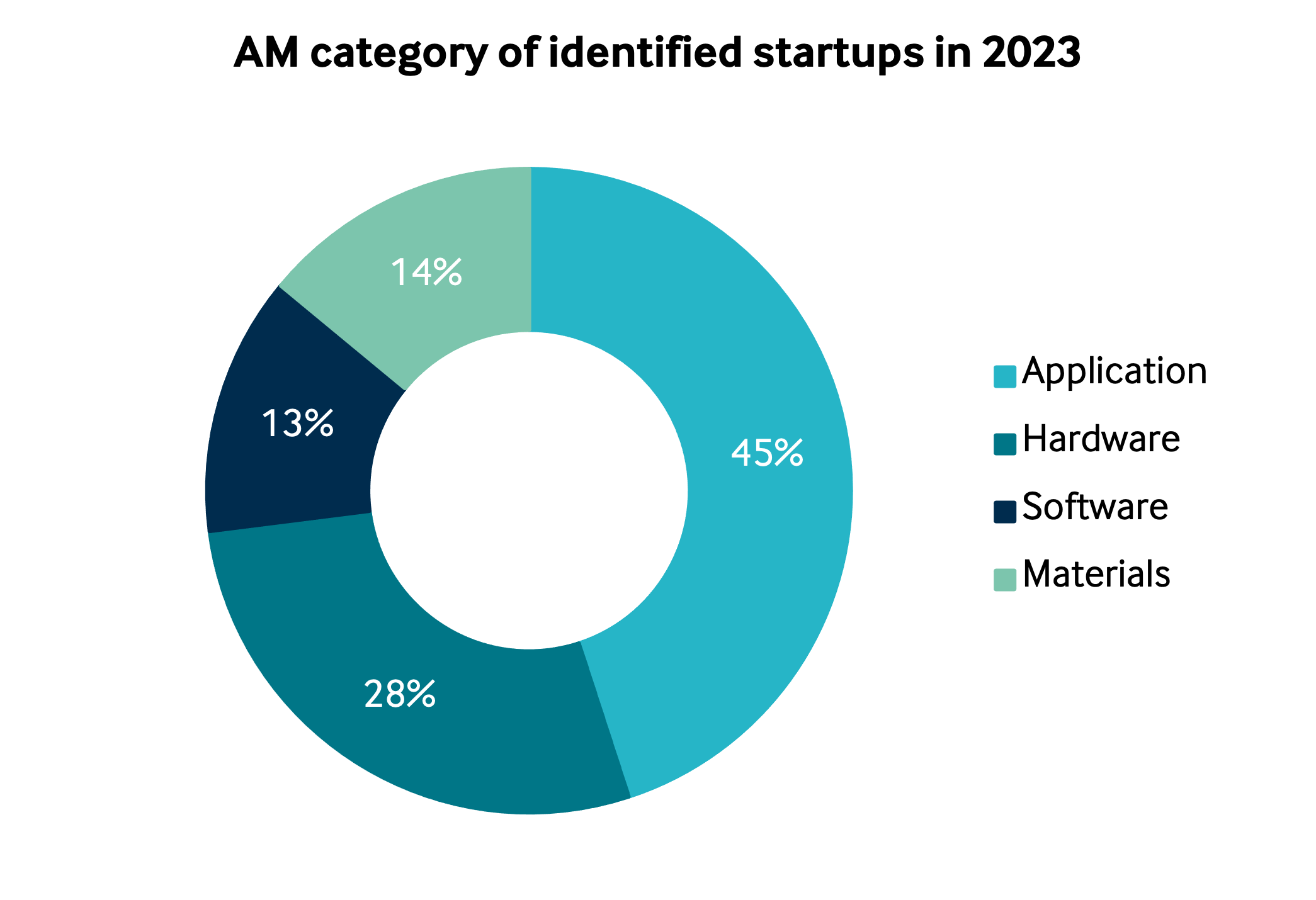What Will Happen with Venture Capital in 2024?
2023 will likely be remembered as a less rosy AM year marked by venture capital (VC) downturn, widespread valuation readjustments in private and public markets, geopolitical uncertainty, rising interest rates, tighter budgets, and longer sales cycles.
Looking back at 2022, despite public AM stock prices that already took a tumble, funding remained robust reaching an all-time high of over USD $2.1 billion (excluding SPAC mergers and IPOs). However, this flipped in 2023, aligning with the broader trend in the VC ecosystem. Last year, startup investments experienced a decline with USD $1.1 billion invested in the AM sector. This significant shift underscores the shortage of capital availability that private companies in the AM sector are currently dealing with. The question now is whether the years 2021, 2022, were statistical outliers. Where is the investment side of the market heading in 2024?

Source: AM Ventures
As we enter 2024, there is a sense that capital markets are stabilizing on an upward trajectory. A soft landing is expected. That is good news for the AM industry, because healthy capital markets are a necessary support system to drive sales growth. Nevertheless, while optimistic capital markets are a necessary condition, they are not sufficient for the adoption of AM. We recognize that issues within our industry play a role in its overall stagnation.
Stabilizing the technology
Due to the variety of different options within the diverse AM technology stack, selecting the right technology for one’s business can be an overwhelming task. Marketing messages that promise lights-out manufacturing at scale for end-use parts can lead to disappointment when faced with the reality that AM technologies are still in their infancy. Our industry does not need additional and new printing methods, concepts, and approaches to AM. Now, companies making machines should focus on stabilizing the technology and improving the quality output of their AM machines to meet the demands of soaring production volumes: consistent, repeatable, reliable parts and value chains that can be integrated in the high-volume manufacturing environments that already exist today. AM technology is not meant to replace conventional manufacturing but serves as an additional offering to produce complex geometries that cannot be manufactured otherwise. Large applications that we already see today will always need more processes than just the Additive part.
“Great technology looking for applications” or “Great applications looking for a technology”?
A significant trend in the industry revolves around a continued emphasis on applications, particularly in sectors such as energy efficiency, electromobility, and cleantech. The urgency to combat climate change positions additive manufacturing as a pivotal player in developing technical solutions, with materials emerging as a critical factor for innovative applications.
In 2023, as shown in the following chart, most of the companies identified were focused on applications. This trend has been visible on AM Venture’s tech radar for about three years. It is a promising indicator since these startups are the justification for our industry’s existence.

Source: AM Ventures
Strategic moves: consolidation through mergers and acquisitions
Addressing the question of profitability, consolidation emerges as a strategic move within the AM sector, aligning with trends seen in other tech sectors. Mergers and acquisitions not only respond to a challenging funding environment but also present an opportunity for companies to optimize economies of scale, fortify balance sheets, and create sustainable business models. We expect a continued consolidation phase in 2024.
AM as the Core Discipline of Advanced Manufacturing
Last year’s macroeconomic headwinds underscore the pressures on legacy manufacturing itself. Software has not eaten the world. Investors from mainstream and consumer-facing technologies are turning their funds towards advanced manufacturing technologies. The surge in manufacturing tech funding during the third quarter of 2023, reaching USD $4.3 billion (see CB Insights), underscores investor’s confidence in the future of advanced manufacturing, with AM at its forefront. This shift will have a positive impact on the investment climate in our industry. Funds are available to provide further support to the most innovative AM startups that are solving real pain points in legacy manufacturing.
For us, AM is the core discipline of advanced manufacturing supported by automation through robotics and automatization through industrial IoT. These adjacent technologies will help to build trust in AM and enable the production of consistent, repeatable, and reliable parts.
Energy efficiency, supply chain resilience and climate-tech: our world’s most pressing challenges will not be resolved by changing human behavior but rather through advanced manufacturing solutions and the key for this is Additive Manufacturing.
Arno Held, Managing Partner at AM Ventures, will be participating at the upcoming Additive Manufacturing Strategies business summit in New York, February 6 to 8, 2024. Held will be giving the keynote “Venture Capital” and will be speaking on the panel “Printing Money: M&A and Public Markets.” AM Ventures is also the Networking Sponsor for the Networking Reception: Bavarian Beer and Pretzels.
Subscribe to Our Email Newsletter
Stay up-to-date on all the latest news from the 3D printing industry and receive information and offers from third party vendors.
You May Also Like
New Report: Semiconductor Industry to See $1.4B in 3D Printing Revenues by 2032
“The semiconductor sector has become the most strategically significant area of global industry.” Truer words are hard to come by when it comes to the modern world, and they are...
Will Photonic-Crystal Lasers Revolutionize 3D Printing?
Powder bed fusion (PBF) for metals and polymers predominantly utilizes lasers as the primary heat source. Some directed energy deposition (DED) technologies also employ lasers, while various vat polymerization methods...
3D Printing Unpeeled: Orbex Investment, IndoMIM and HP, Ultrasonic Waves
INDO-MIM has bought three HP Metal Jet S100 printers, operating two in India and one in Texas. This is a win for HP because the company has deep experience in...
3D Printing Webinar and Event Roundup: April 21, 2024
It’s another busy week of webinars and events, starting with Hannover Messe in Germany and continuing with Metalcasting Congress, Chinaplas, TechBlick’s Innovation Festival, and more. Stratasys continues its advanced training...































